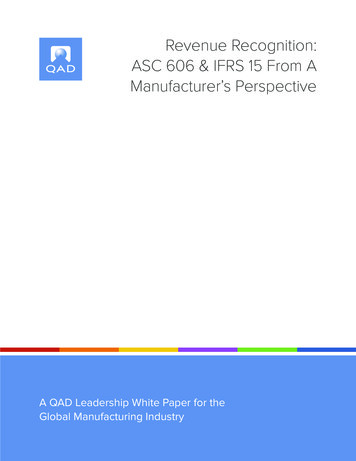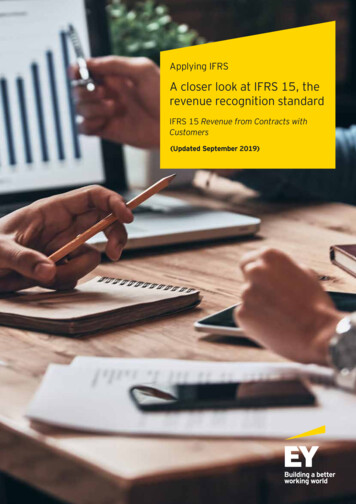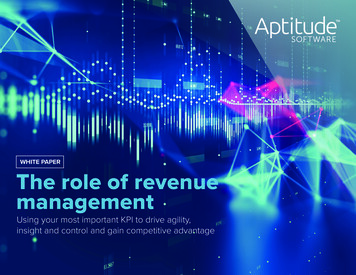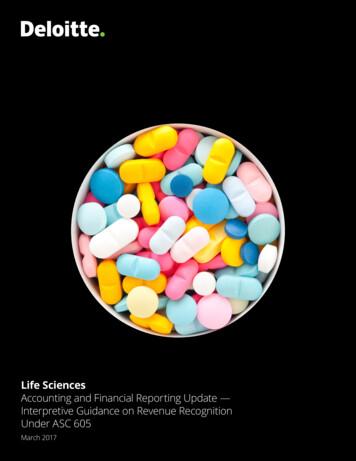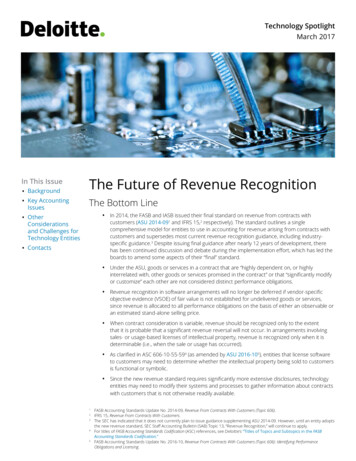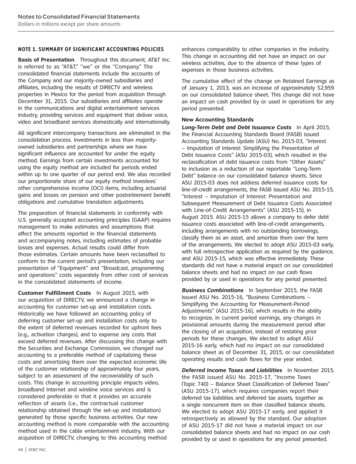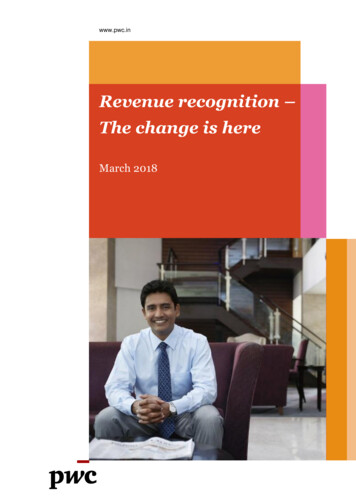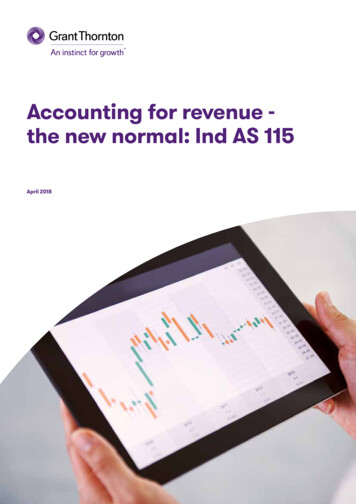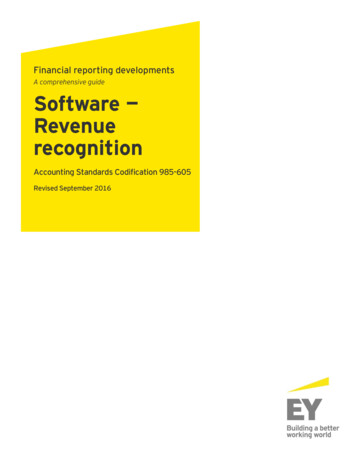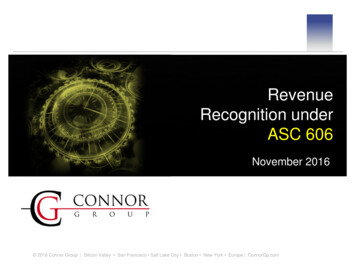
Transcription
RevenueRecognition underASC 606November 2016 2016 Connor Group Silicon Valley San Francisco Salt Lake City Boston New York Europe ConnorGp.com
1Revenue Recognition under ASC 606Introduction2Index by Topic3ASC 606 Technical Overview4Post 606 Revenue World24Connor Group Implementation Strategy101About Connor Group113 2016 Connor Group Silicon Valley San Francisco Salt Lake City Boston New York Europe ConnorGp.com
Introduction2To our clients and friendsIn May 2014, the Financial Accounting Standards Board (FASB) released Accounting Standards Update No. 2014-09, Revenue fromContracts with Customers (Topic 606). The new standard, scheduled to go into effect in 2018, will impact in some ways or othersmost, if not all, companies that follow US accounting principles. Its complexity arises not just from the volume (close to 150 pages ofauthoritative content related to revenue, and an additional 500 pages of changes to other topics and background material), but alsofrom transition to a principle-based approach that requires matching specific circumstances of revenue transactions to concepts,criteria, and assessment factors dispersed throughout the standard and often requiring considerable judgment to apply.Over the past several years, Connor Group has been in the forefront of the evolving revenue landscape, assisting many companieswith the adoption of the existing multiple-element revenue guidance released in 2009, helping tackle other complex revenuerecognition issues, and participating in the ASU 2014-09 drafting process through comment letters and roundtables. In doing so, wehelped companies develop methods and approaches to revenue recognition that are widely used today across multiple industries.We are now helping clients implement ASU 2014-09, both technical and operational aspects, applying our customary technicalthought leadership, practical approach, and excellence in execution.We have prepared this publication for the benefit of industry executives, revenue professionals and others, with a view to presentASU 2014-09 content by potential topic of interest, in a concise, easy to review manner, handy to use as a reference tool. Forpractical benefit, the attached material includes, in addition to the information directly from the new standard, our judgments andinterpretations of how its provisions could be applied in typical revenue circumstances, a list of key impacts of the standard adoptionby industry, and a summary of our implementation roadmap. These are based on our understanding of the concepts underlying thestandard, background material information, and early publications from the accounting industry. There are many areas in the newstandard which are subject to interpretation and judgment, which may differ among professionals. As the ASC 606 landscapecontinues to evolve, we will update this publication on a periodic basis.This publication has been updated to reflect the effect of ASC 606 amendments released through October 2016.Your Connor Group Team 2016 Connor Group Silicon Valley San Francisco Salt Lake City Boston New York Europe ConnorGp.com
Index by Topic3Acceptance by customer40Fulfilment costs93Product liability claims50Adoption25Gross/net presentation86Professional service industryBad debt85IFRS 15 vs. ASC 606 differences97-100 Key impact areas15,16Balance sheet presentation84Implementation Summary revenue recognition45Bill and hold arrangements42 Approaches and next steps110Real estate industry – key impact19Breakage77 Key documentation111Rebates and chargebacks75Bundled performance obligations51 Strategy101-111Recent developments23,112Cloud services industryInstallation/implementation servicesRefunds for services70 Key impact areas17.Key impact areas13,15,16Repurchase agreements91 Summary revenue recognition46 Summary revenue recognition48Reseller arrangements78-80Collectibility36Intangibles – sales63Returns69Concessions and customer satisfaction72Internet service industry – key impact areas 17Revenue recognition model8,27Consideration payable to customers73Key impact areas by industry10-22Royalties58,67Consignment arrangements41Licenses52Shipping and handling costs and fees87Consumer goods industry – key impact areas 20Life science industrySoftware industryContact information (Connor Group)116 Key impact areas18 Key impact areas11,12Contracts Revenue recognition57,58 Revenue recognition issues53-56 Criteria for contracts33,37Loss (onerous) contracts94Solar industry – key impact areas19 Duration34Loyalty and point obligations76Standalone selling prices (SSP)8188 Linking34Milestones and other performance fees58,59Taxes billed to customer (sales, VAT, etc.Technology industry - key impact13,14 Modifications35Noncash consideration68Terminology changes9 When criteria are not met37Nonrefundable upfront fees47Coupons75Transaction priceNRE arrangements60 Allocation82Custom-built products43Optional goods or services61,62 Changes83Customer support servicesOrigination costs92 Estimating64 Key impact areas12,14Other than revenue accounting areasTransfer of control39 Summary revenue recognition49 Key impact areas22Transition methods25,26DisclosuresOverview5-8Unexercised rights77 Footnotes95Performance obligations29Variable consideration Key impact areas21 Immaterial31 Constraint66 Quantitative96 Internal activities32 Estimation methodologies65Distinct goods or services30 Protective provisions32Expense reimbursement by customers89Volume discounts74 Satisfied over time (criteria)38Extended payment terms71Warranty obligations50 Satisfied over time (measuring progress)44Financing component90 What is not a performance obligation31,32Fixed assets – sales63Portfolio approach28 2016 Connor Group Silicon Valley San Francisco Salt Lake City Boston New York Europe ConnorGp.com
ASC 606 Technical Overview 2016 Connor Group Silicon Valley San Francisco Salt Lake City Boston New York Europe ConnorGp.com4
Fast Facts5 ASC 606, Revenue from Contracts with Customers Released May 2014, amendments in 2015-2016 Largely the same standard for US GAAP and IFRS Effective Jan 1, 2018 for public companies, Jan 1, 2019 forprivate companies (2017 early adoption permitted) Adoption alternatives:i.Re-cast all prior periods presented as if applied tothose periodsii. Apply from current period only to all contracts, with preadoption cumulative effect on retained earnings 2016 Connor Group Silicon Valley San Francisco Salt Lake City Boston New York Europe ConnorGp.com
Why Investors Care6 Likely to impact reported revenue and expenses Makes revenue more volatile, less predictable Requires extensive business-focused revenue disclosures Expensive to adopt Operational and system changes Requires new technical judgments Permanently “lost” or “recycled” revenue upon adoption Opportunities to align with business strategy 2016 Connor Group Silicon Valley San Francisco Salt Lake City Boston New York Europe ConnorGp.com
Why New Standard7 Converge (mostly) US GAAP with IFRS Single principle-based standard for all Eliminate hundreds of today’s revenue pronouncements Inconsistencies and hard to navigate – from many yearsof accounting evolution and many ‘cooks’ Special industry treatments Principles instead of prescriptions 2016 Connor Group Silicon Valley San Francisco Salt Lake City Boston New York Europe ConnorGp.com
Framework OverviewStep 1Step 2 Identify contract with customer Identify performance obligations Determine expected transaction priceStep 3Step 4(consideration) Allocate to performance obligations Recognize revenue upon transfer of controlover goods/servicesStep 5 2016 Connor Group Silicon Valley San Francisco Salt Lake City Boston New York Europe ConnorGp.com8
9Language ChangesOldNewElement, deliverablePerformance obligationDeliveryTransfer (of control), satisfaction (of obligation)Price, considerationTransaction priceFixed or determinableVariable considerationPercentage of completionMeasuring progressStandalone valueDistinct (goods or services)VSOE, Estimated Selling PriceStandalone Selling Price (SSP)Contingent revenueContract assetDeferred revenue, depositsContract liability 2016 Connor Group Silicon Valley San Francisco Salt Lake City Boston New York Europe ConnorGp.com
Key Impact Areas – Multiple Industries10 Okay to retain certain delivery risks when taking revenue(assess transfer of control) Estimate and accrue for concessions, returns, refunds,rebates, other uncertainties when recognizing revenue If collectibility uncertain, record revenue on full payment, orto the extent of cash received if delivery ended/stopped Recognize financing component if significant Capitalize commissions and other direct incremental costs “Lost” or “recycled” revenue upon adoption Consider portfolio approach where expedient Apply to sales of fixed assets and intangibles 2016 Connor Group Silicon Valley San Francisco Salt Lake City Boston New York Europe ConnorGp.com
Key Impact Areas – Software (1) Can relax pricing of support and services (VSOE notrequired) Recognize most license revenue up front even wheresupport/services do not have VSOE Most term licenses recognized upfront Roadmaps/specific upgrades do not prevent revenuerecognition Pricing of add-on license seats will matter Can offer flexible software upgrade optionsSee also separate slides for cloud and professional services. 2016 Connor Group Silicon Valley San Francisco Salt Lake City Boston New York Europe ConnorGp.com11
Key Impact Areas – Software (2)12 Multi-element allocation can be more complex (relativeprices, judgmental allocations for variable fees) Okay to estimate revenue for extended payment terms May need to bifurcate updates from support and go nonstraight-line Support renewal option may require revenue allocation/deferral if at below normal pricingSee also separate slides for cloud and professional services. 2016 Connor Group Silicon Valley San Francisco Salt Lake City Boston New York Europe ConnorGp.com
Key Impact Areas – Technology (1)13 Sell-through revenue with distributors gone in manyinstances Multi-element allocation different (relative prices, revenuenot limited to non-forfeitable) Option for additional goods requires revenue allocation/deferral if at below normal pricing 2016 Connor Group Silicon Valley San Francisco Salt Lake City Boston New York Europe ConnorGp.com
Key Impact Areas – Technology (2)14 Service components of warranty (standard or non-standard)– i.e. beyond product assurance – require revenueallocation/deferral (unless immaterial) For extended warranty/maintenance, continue to record lossupfront, but follow standard allocation process Trade-in provisions could be treated as right of return, leasesor financing arrangements Sale of assets under operating leases (or to be leased bypurchaser) recognized despite continuing involvement Estimate earned royalties (no lag method) 2016 Connor Group Silicon Valley San Francisco Salt Lake City Boston New York Europe ConnorGp.com
Key Impact Areas – Professional Services (1)15 Combine with software/hardware if these elements delivercombined output to the customer Over-time recognition may require enforceable right toprogress payments, or customer access to WIP Revenue on completion if cannot estimate progress Could take revenue before acceptance (if probable and canestimate progress) 2016 Connor Group Silicon Valley San Francisco Salt Lake City Boston New York Europe ConnorGp.com
Key Impact Areas – Professional Services (2)16 No margin normalization (percentage of completion) No milestone method Continue to record loss upfront for construction type andsoftware customization services 2016 Connor Group Silicon Valley San Francisco Salt Lake City Boston New York Europe ConnorGp.com
Key Impact Areas – Cloud and Internet Services17 Free or discounted implementation may require revenueaccrual (revenue not limited to non-forfeitable) Implementation may be combined with cloud service even ifit could be provided by 3rd party Nature of promise to customer will determine if fees can berecorded straight line or as-earned Contract renewal option requires revenue allocation/deferralif at below normal pricing (e.g. no setup) Gross/net based on control of 3rd party goods/servicesbefore transfer to customer (vs. primary obligor)See also separate slides for software and professional services. 2016 Connor Group Silicon Valley San Francisco Salt Lake City Boston New York Europe ConnorGp.com
Key Impact Areas – Life Sciences18 Asset development part of collaboration may not becustomer activity or revenue License with ongoing R&D may have to be amortized ifcontrol over development is retained Cannot default to straight-line if license is to be amortized No milestone method (estimate outcome and use pattern ofdelivery) Estimate earned royalties (no lag method) Sell-through model with distributors gone in many instances 2016 Connor Group Silicon Valley San Francisco Salt Lake City Boston New York Europe ConnorGp.com
Key Impact Areas – Real Estate and Solar19 No changes for sales-type or operating lease transactions If entire amount not deemed probable to collect, no revenueuntil full payment or until full delivery (to the extent of cashreceived) No initial/continuing investment criteria, but customer musthave control of the asset sold Estimate impact of continuing involvement and recognizerevenue Sale of assets under operating leases (or to be leased bypurchaser) recognized despite continuing involvement 2016 Connor Group Silicon Valley San Francisco Salt Lake City Boston New York Europe ConnorGp.com
Key Impact Areas – Consumer Goods20 Coupons, reward programs/ points may require revenueallocation/deferral as options Estimate breakage revenue and recognize proportionately Extended warranty requires different revenue allocation(relative prices) Re-evaluate virtual goods revenue model 2016 Connor Group Silicon Valley San Francisco Salt Lake City Boston New York Europe ConnorGp.com
Key Impact Areas – Quantitative Disclosures21 Revenue by timing*, nature, geography, channel; tie tosegment revenues Contract assets and liabilities* (contingent and deferred revenue) Changes in contract assets and liabilities Current revenue related to past period obligations Amount and timing of future revenue (contracts 1 year) Deferred costs, amortization and impairment Impairment for receivables and contract assets* Gross up receivables and contract liabilities** Required for private companies; all other only required for public companies 2016 Connor Group Silicon Valley San Francisco Salt Lake City Boston New York Europe ConnorGp.com
Key Impact Areas – Non-Revenue22 Income taxes Compensation: performance awards, profit sharing metrics Purchases: apply concept of control transfer? Royalties payable: royalties based on GAAP revenue Business combinations: due diligence, pricing, earn-outs Borrowings: financial covenants Non-cash consideration paid: measurement date SEC significance tests for acquisitions and dispositions (inparticular, with retrospective adoption) Auditor materiality (with retrospective adoption) 2016 Connor Group Silicon Valley San Francisco Salt Lake City Boston New York Europe ConnorGp.com
Recent Developments23 Additional deferrals unlikely Standard clarifications (most were approved by FASB in 2016) Licenses (functional v. symbolic model) When item is distinct within context of contract (e.g. razor and razor blade, integration) Immaterial obligations Contracts modified before ASC 606 adoption Shipping and handling fees and sales taxes Value of noncash consideration Collectibility Principal v. agent Timing of receivable recognition (draft exposed for comments – not yet approved) Transition Resource Group Consensuses around various technical matters – mandatory for public companies! AICPA Revenue Recognition Task Forces (Software, Telecom, etc. – total 16 task forces)– a number of issues exposure draftsGuidance 2016 Connor Group Silicon Valley San Francisco Salt Lake City Boston New York Europe ConnorGp.com
Post 606 Revenue World 2016 Connor Group Silicon Valley San Francisco Salt Lake City Boston New York Europe ConnorGp.com24
Selected Data FinancialsAdoption and Transition Adoption dates alternatives25(EGC public entities: private company dates OK unless elected not to use them)Periods beginning after Dec. 15, .201620172018Years Public PrivatePublic PrivateEGC PrivateQuarters Public PrivatePublic PrivateEGC Private2019Private Transition methodsFull retrospective(with prior periodrecasting)Retrospectivewithout prior periodrecasting Recast all periods presented in financials Okay to exclude intra-year contracts and use hindsight for estimates (complete contracts) Disclosures for all periods presented No change to prior periods Okay to apply either to all contracts, or only tocontracts with remaining ASC 605 revenueDual reporting for year of adoption Okay to combine pre-transition contract modifications with original contract terms Recognize cumulative effect on retained earnings at date of initial applicationGuidance606-10-65-1; 2016 Guides: EY 1.2, 1.3; KPMG 13; PwC 13.2, 13.3; DT 15.1, 15.2 2016 Connor Group Silicon Valley San Francisco Salt Lake City Boston New York Europe ConnorGp.com
26Choice of Transition MethodBenefits ofFull Retrospective Comparable financial information fromadoption date Less distraction to investors Clean start to IPO Reflect pre-adoption business changesproperly Easier transition if significant adoptiondate impactGuidanceBenefits ofRetrospective without recasting 1 year of dual reporting instead of 2 More time to adapt business to mitigateimpact More time for implementation Additional resources available Avoid extra work if revenue is a lessimportant metric Full retrospective adoption may requireadditional (3rd prior) year converted toASC 606 when filing registrationstatements606-10-65-1; 2016 Guides: EY 1.3; KPMG 13; PwC 13.3; DT 15.2; KPMG Revenue Transition Options guide 2016 Connor Group Silicon Valley San Francisco Salt Lake City Boston New York Europe ConnorGp.com
Contract-Level Revenue Recognition ModelStep 2Step 1Identify contractIdentifydistinctperformanceobligationsStep 5Recognizerevenueupontransfer ofcontrolStep 3Determine expectedtransaction priceStep 4Allocate toperformanceobligationsusing SSPGuidance606-10-5-4 2016 Connor Group Silicon Valley San Francisco Salt Lake City Boston New York Europe ConnorGp.com27
28Portfolio ApproachIndividualContractsPortfolioApproach(A) Apply to eachindividual contract Aggregate contracts AggregateperformanceobligationsHybrid Approach(A) Individual and portfolioapproaches fordifferent aspects ofrevenue recognition(A) Available to aggregate items with similar characteristics, and provided there isReasonable expectation that effects would not differ materially (quantitative comparison not required) Practical application examples: Identifying deliverables and allocating consideration across multiple contracts Estimating variable consideration across multiple contracts/customers Credit assessment across multiple customersGuidance606-10-10-4; 2016 Guides: EY 3.3.1; KPMG 4.4; PwC 1.3.3; DT 3.1.2.2 2016 Connor Group Silicon Valley San Francisco Salt Lake City Boston New York Europe ConnorGp.com
29Performance Obligations Identify at contract inception as performance obligations: Distinct goods / services (or bundles) Distinct, satisfied over time, with same pattern of transfer, and substantially the sameitems (“series”) – must aggregate into a single performance obligation Daily, monthly (does not need to be consecutive) – or units of quantity Include implied obligations (e.g. business practice) if create a customer expectation Even if legally unenforceableEXAMPLES:Goods (sale, resale)ServicesProducing/developing on behalf of otherLicenses (e.g. IP, software)Options to purchase goods/services (if there is amaterial right)Rights to future goods/services for resaleStand-ready service (e.g. if and when available, if andwhen requested/unspecified, access to good/service) Master supply agreement is not a stand-readyMaking arrangements for others (e.g. as agent)Resale of rights to goods/services (e.g. tickets)Guidance606-10-25-14 through 16 and 18; 2016 Guides: EY 4.1, 4.2; KPMG 5.2; PwC 3.3; DT 5.2.1, 5.2.2, 5.2.2.1, 5.3.1, 5.3.3 2016 Connor Group Silicon Valley San Francisco Salt Lake City Boston New York Europe ConnorGp.com
Distinct Goods or Services30[replaces Standalone Value; Essential Undelivered Elements]Capable of being distinctDistinct in context ofcontract Can be used, consumed, sold,held for economic benefits On its own, or With resources alreadyobtained from entity or fromother transactions, or With resources soldseparately (by any entity) aka “separately identifiable” Combined output requested bycustomer is nature of promise.Indicators include: Significant integration Significantly modify orcustomize another item Each item is significantlyaffected by other item(s) Separable execution risksEXAMPLESLikely not distinct: Materials, tasks, etc.used in construction Equipment withcomplex installation Software license withsignificant integrationor modification Software integral tohardware or requiringa service or updatesDistinct goods / servicesGuidance Product developmentwith prototypes606-10-25-19 through 22, 55-56; 2016 Guides: EY 4.2.1; KPMG 5.2.1, 5.2.3; PwC 3.4; DT 5.3.2 2016 Connor Group Silicon Valley San Francisco Salt Lake City Boston New York Europe ConnorGp.com
Miscellaneous Obligations [replaces Inconsequentialand Perfunctory; Incidental Obligations]31 Immaterial performance obligations do not need to be identified Assessment in the context of a contract (or at entity level) (does not apply to options!) Potential examples: installation, training, warranty service, when and if available IPupdates, phone support Accrue costs related to immaterial obligations if revenue already recognized Free handsets, free car maintenance, etc. are performance obligations (unless immaterial) Do not qualify as performance obligations: Warranty if limited to assurance of compliance with specifications Optional goods/services if the option does not convey a material right (marketing offers) Credit card fees and related reward programs (if represent interest yield – ASC 310) Consider if performance obligations: Contingent deliverables subject to R&D or other uncertainties – stand-ready obligations? Pre-production or pre-sale activities (does control transfer?)Guidance606-10-25-16A, 16B, 55-32, 42 and 43; TRG 1/2015, 7/2015 and 11/2015;2016 Guides: EY 4.1.1; KPMG 5.2.4; PwC 3.2.1, 3.6.2; DT 5.2.3, 5.2.4.1 2016 Connor Group Silicon Valley San Francisco Salt Lake City Boston New York Europe ConnorGp.com
Internal Activities and Protective Provisions32 Do not represent performance obligations: Internal activities to fulfill customer contract that do not transfer goods/services Certain protective provisions more EXAMPLESEXAMPLES Administrative tasks toset up a contract Promises embedded inlicenses Other internal activities Product liabilityprovisions IP indemnificationprovisions Promises to defend IP(patents, trademarks,copyrights)See also Shipping& Handling slide! Maintaining softwarecode in escrow Protective software“sunset” clauses Other rights protectingcustomer, vendor orgoods/services Maintaining own IP rightsGuidance606-10-25-17; 55-35 and 64A; Ex 57; TRG 1/2015; 2016 Guides: EY 4.1; KPMG 5.2.2; PwC 3.6.1, 3.6.3; DT 5.2.4 2016 Connor Group Silicon Valley San Francisco Salt Lake City Boston New York Europe ConnorGp.com
Customer Contracts [replaces Evidence of Arrangement]33 Customer is a party that contracts to obtain output of ordinary activities for consideration Agreement between two or more parties that creates enforceable rights and obligations Enforceability is a matter of law Consider entity contract practices and processesto determine whether/when enforceable Written, oral or implied by customary business practices Contributions are not in scope Collaborations may be in scopeif contracting for ordinaryactivities output – or could beanalogized to ASC 606 No contract if each party can unilaterally terminate and wholly unperformed Parties must approve (in writing, orally, or per other customary business practices) and besubstantially committed to perform Contract must allow to identify: Each party’s rights regarding goods/services Payment terms Collection of amounts for goods/etc. that will be delivered must be assessed as probableGuidance606-10-25-1.a through d, 25-2 through 4; TRG 3/15; 2016 Guides: EY 3.1; KPMG 5.1.1; PwC 2.6; DT 4.2, 4.7 2016 Connor Group Silicon Valley San Francisco Salt Lake City Boston New York Europe ConnorGp.com
Contract Unit of Account / Combination34[replaces Linking] ASC 606 guidance is applied to the performance obligations over duration of the contract Duration of contract: period in which parties have present enforceable rights and obligations Right to cancel in exchange for substantive termination penalty is evidence of enforceable rightsCONSIDEREXCLUDEINCLUDE Legal term Renewal terms Marketing offers Enforceableobligations period Optional items Mutual terminationrights at nosubstantive cost Cancellation rights( option?) if material rights areconveyed Combine separate contracts with the same customer if: Entered into at or near the same time, and one or more of these applies:Guidance Contracts negotiated as a package with a single commercial objective Consideration in one contract depends on price/performance of the other contract Some or all goods/services are a single performance obligation606-10-25-9, 55-42, 43 and 45; TRG 10/14 and 11/2015;2016 Guides: EY 3.2, 3.3; KPMG 5.1.2, 5.1.4; PwC 2.7, 2.8; DT 4.6 2016 Connor Group Silicon Valley San Francisco Salt Lake City Boston New York Europe ConnorGp.com
35Contract Modifications Change in scope and/or price approved by the parties OK to estimate price change even if not yet approved Apply appropriate modification model based on criteria, facts and circumstancesCRITERIAGoods or ServicesIMPACTPriceOriginal –TransferredOriginal –RemainingModificationModificationNo changeNo changeAdditionalAdjusted SSPNo changeDistinct from transferredN/AContractOriginal –TransferredOriginal –RemainingModificationNo changeTerminatedNewNew Bring over remaining revenue New allocation, new SSPNot distinct from transferredN/ACombined Some distinct and some notN/ARecalculate progressCumulative revenue catchup“consistent with the objectives” manner (hybrid) Modifications should also meet one of contract combination criteria (except time proximity)Guidance606-10-25-9 through 13; 2016 Guides: EY 3.4; KPMG 7.1, 7.2; PwC 2.9; DT 9 2016 Connor Group Silicon Valley San Francisco Salt Lake City Boston New York Europe ConnorGp.com
Collection is Probable[replaces Collectibility is Probable/Reasonably Assured]36 Objective is to determine whether contract is valid, genuine transaction Assessment limited to amounts for goods/etc. that will be delivered – not the entire contract! Consider expected potential concessions and other variable consideration Concession v. lack of full collectibility Consider prepayments and ability to suspend goods/etc. delivery on non-payment If collection is probable, re-assess if significant change in facts/circumstances If collection is not probable, contract criteria are not met re-assess quarterly Only consider customer’s ability and intention to pay No explicit assessment scope required (credit score/check, financials, history, etc.) Portfolio approach for similar contracts if effects would not differ materially Insuring or factoring AR does not make collection probableGuidance606-10-25-1.e, 25-3, 25-5, 25-6, 55-3A through 3C; TRG 1/2015;2016 Guides: EY 3.1.5; KPMG 5.1.1; PwC 2.6.1.5; DT 4.2.5 2016 Connor Group Silicon Valley San Francisco Salt Lake City Boston New York Europe ConnorGp.com
Contract Criteria Are Not Met[replaces Cash Receipt Based Revenue]37 Contract criteria required to meet to enable recognition of any revenue:Rights and obligations are enforceableApproved and parties committed to performParties’ rights regarding goods andservices can be identifiedPayment terms can be identifiedContract has commercial substanceProbable collection of amounts for goods/etc. that will be supplied If not met, only recognize revenue: On cash basis - only if entity transferred goods/etc. it got paid for, has stoppedtransferring additional goods, and has no remaining obligations to transfer On contract completion: either of the following No remaining performance obligations, and substantially all consideration received Contract terminated On reassessment (quarterly if not met) Record consideration received as deposit or contract liability if cannot be recognizedGuidance606-10-25-7 and 8; 2016 Guides: EY 3.5; KPMG 5.1.3; PwC 2.6.2; DT 4.5 2016 Connor Group Silicon Valley San Francisco Salt Lake City Boston New York Europe ConnorGp.com
Obligation Satisfied Over Time or At a Point InTime [replaces Delivery Model]Simultaneous receipt and consump
Revenue recognition model 8,27 Royalties 58,67 Shipping and handling costs and fees 87 Software industry Key impact areas 11,12 Revenue recognition issues 53-56 Solar industry - key impact areas 19 Standalone selling prices (SSP) 81 Taxes billed to customer (sales, VAT, etc. 88 Technology industry - key impact 13,14 Terminology changes 9
